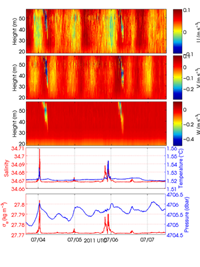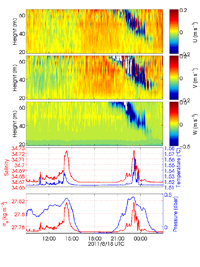Data Graphics Library

April 2nd, 2014 Chile earthquake, magnitude 8.2, detected by the ACO broadband hydrophone. The x axis is UTC time in hh:mm:ss. The red curve shows the energy band-passed between 0.01-0.15 Hz and the blue curve is the data from 3.5 -10 Hz. The large high frequency signal is the T-phase arrival from the earthquake source. (graphic by Fred Duennebier)
Preliminary data from the ADP, CTD, and pressure sensor on the observatory frame are shown in these plots. The relatively large, and intermittent variability measured by the CTD and pressure sensors appears to be caused by heating of the observatory. The variability in the ADP data was caused by interference with the CTD, the problem was subsequently solved by alternating the instruments sampling.
(click on the thumbnail to enlarge the figure)


(From left)
Graph 1: Three day temperature, salinity, pressure and current time-series.
Graph 2: 24 hour temperature, salinity, pressure and current time-series.


A rain event on 2012/03/06 at about 1800-2100 UTC was visible at higher frequencies on the ACO hydrophone. The radar image shows the storm passing through the location of the ACO, and the plot contains cumulative rain, rain rate, and wind speed from the WHOTS buoy. The bottom is the difference spectrogram. The big changes in acoustic level appear to be wind-related, but there are obvious signals associated with the rain that likely go well above 12 KHz. The cumulative rain appears to have reached some limit late on Mar 5.

This figure shows the time series of a swarm of 16 micro-earthquakes that were observed at ACO on June 4, 2012. The similarities between the events strongly imply that their source locations were close to each other, and the high frequencies and sharpness of the arrivals imply very small source energies, too small to be observed by sensors on the islands. Similar swarms, typical of seismic events generated by volcanic activity, are observed occasionally at ACO.